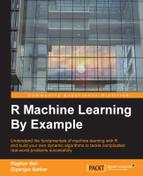Machine learning, when you first hear it, sounds more like a fancy word from a sci-fi movie than the latest trend in the tech industry. Talk about it to people in general and their responses are either related to being generally curious about the concept or being cautious and fearful about intelligent machines taking over our world in some sort of Terminator-Skynet way.
We live in a digital age and are constantly presented with all sorts of information all the time. As we will see in this and the coming chapters, machine learning is something that loves data. In fact, the recent hype and interest in this field has been fueled by not just the improvements in computing technology but also due to exponential growth in the amount of data being generated every second. The latest numbers stand at around 2.5 quintillion bytes of data every day (that's 2.5 followed by 18 zeroes)!
Note
Fun Fact: More than 300 hours of video data is uploaded to YouTube every minute
Source: https://www-01.ibm.com/software/data/bigdata/what-is-big-data.html
Just take a deep breath and look around. Everything around you is generating data all the time, of all sorts; your phone, your car, the traffic signals, GPS, thermostats, weather systems, social networks, and on and on and on! There is data everywhere and we can do all sorts of interesting things with it and help the systems learn. Well, as fascinating as it sounds, let us start our journey on machine learning. Through this chapter we will cover:
- Understanding machine learning
- Algorithms in machine learning and their application
- Families of algorithms: supervised and unsupervised
Aren't we taught that computer systems have to be programmed to do certain tasks? They may be a million times faster at doing things but they have to be programmed. We have to code each and every step and only then do these systems work and complete a task. Isn't then the very notion of machine learning a very contradictory concept?
In the simplest ways, machine learning refers to a method of teaching the systems to learn to do certain tasks, such as learning a function. As simple as it sounds, it is a bit confusing and difficult to digest. Confusing because our view of the way the systems (computer systems specifically) work and the way we learn are two concepts that hardly intersect. It is even more difficult to digest because learning, though an inherent capability of the human race, is difficult to put in to words, let alone teach to the systems.
Then what is machine learning? Before we even try to answer this question, we need to understand that at a philosophical level it is something more than just a way to program. Machine learning is a lot of things.
There are many ways in which machine learning can be described. Continuing from the high level definition we presented in the previous chapter, let us go through the definition given by Tom Mitchell in 1997:
"A computer program is said to learn from experience E with respect to some task T and some performance measure P, if its performance on T, as measured by P, improves with experience E."
Note
Quick Note about Prof Tom Mitchell
Born in 1951, he is an American computer scientist and professor at Carnegie Mellon University (CMU). He is also the chair of the machine learning department at CMU. He is well known for his contributions in the fields of machine learning, artificial intelligence, and cognitive neuroscience. He is part of various institutions such as the Association for the Advancement of Artificial Intelligence.
Now let us try to make sense out of this concise yet powerful definition with the help of an example. Let us say we want to build a system that predicts the weather. For the current example, the task (T) of the system would be to predict the weather for a certain place. To perform such a task, it needs to rely upon weather information from the past. We shall term it as experience E. Its performance (P) is measured on how well it predicts the weather at any given day. Thus, we can generalize that a system has successfully learned how to predict the weather (or task T) if it gets better at predicting it (or improves its performance P) utilizing the past information (or experience E).
As seen in the preceding example, this definition not only helps us understand machine learning from an engineering point of view, it also gives us tools to quantify the terms. The definition helps us with the fact that learning a particular task involves understanding and processing of the data in the form of experience. It also mentions that if a computer program learns, its performance improves with experience, pretty similar to the way we learn.
